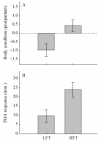Food restriction affects maternal investment but not neonate phenotypes in a viviparous lizard
- PMID: 28409503
- PMCID: PMC5396030
- DOI: 10.24272/j.issn.2095-8137.2017.011
Food restriction affects maternal investment but not neonate phenotypes in a viviparous lizard
Abstract
Food availability significantly affects an animal's energy metabolism, and thus its phenotype, survival, and reproduction. Maternal and offspring responses to food conditions are critical for understanding population dynamics and life-history evolution of a species. In this study, we conducted food manipulation experiments in field enclosures to identify the effect of food restriction on female reproductive traits and postpartum body condition, as well as on hatchling phenotypes, in a lacertid viviparous lizard from the Inner Mongolian desert steppe of China. Females under low-food availability treatment (LFT) had poorer immune function and body condition compared with those under high-food availability treatment (HFT). The food availability treatments significantly affected the litter size and litter mass of the females, but not their gestation period in captivity or brood success, or the body size, sprint speed, and sex ratio of the neonates. Females from the LFT group had smaller litter sizes and, therefore, lower litter mass than those from the HFT group. These results suggest that female racerunners facing food restriction lay fewer offspring with unchanged body size and locomotor performance, and incur a cost in the form of poor postpartum body condition and immune function. The flexibility of maternal responses to variable food availability represents an important life strategy that could enhance the resistance of lizards to unpredictable environmental change.
Keywords: Eremias multiocellata; Food availability; Hatchling; Lizard; Reproductive output.
Figures
Similar articles
-
An experimental study of the gestation costs in a viviparous lizard: a hormonal manipulation.Physiol Biochem Zool. 2013 Nov-Dec;86(6):690-701. doi: 10.1086/673099. Epub 2013 Sep 9. Physiol Biochem Zool. 2013. PMID: 24241066
-
Mating does not influence reproductive investment, in a viviparous lizard.J Exp Zool A Ecol Genet Physiol. 2011 Oct 1;315(8):458-64. doi: 10.1002/jez.693. Epub 2011 Jul 5. J Exp Zool A Ecol Genet Physiol. 2011. PMID: 21732546
-
Maternal effects impact decision-making in a viviparous lizard.Biol Lett. 2018 Apr;14(4):20170556. doi: 10.1098/rsbl.2017.0556. Biol Lett. 2018. PMID: 29643218 Free PMC article.
-
Incidence, causes and consequences of pregnancy failure in viviparous lizards: implications for research and conservation settings.Reprod Fertil Dev. 2010;22(5):761-70. doi: 10.1071/RD09195. Reprod Fertil Dev. 2010. PMID: 20450828 Review.
-
Mechanisms of reproductive allocation as drivers of developmental plasticity in reptiles.J Exp Zool A Ecol Integr Physiol. 2018 Jul;329(6-7):275-286. doi: 10.1002/jez.2165. Epub 2018 May 7. J Exp Zool A Ecol Integr Physiol. 2018. PMID: 29733527 Review.
Cited by
-
Maternal food restriction during pregnancy affects offspring development and swimming performance in a placental live-bearing fish.J Exp Biol. 2022 Jan 15;225(2):jeb242850. doi: 10.1242/jeb.242850. Epub 2022 Jan 20. J Exp Biol. 2022. PMID: 34964050 Free PMC article.
-
Successional changes in trophic interactions support a mechanistic model of post-fire population dynamics.Oecologia. 2018 Jan;186(1):129-139. doi: 10.1007/s00442-017-4016-z. Epub 2017 Nov 22. Oecologia. 2018. PMID: 29167982
-
Coping with drought? Effects of extended drought conditions on soil invertebrate prey and diet selection by a fossorial amphisbaenian reptile.Curr Zool. 2022 Jul 22;69(4):367-376. doi: 10.1093/cz/zoac056. eCollection 2023 Aug. Curr Zool. 2022. PMID: 37614919 Free PMC article.
-
High quality diet improves lipid metabolic profile and breeding performance in the blue-footed booby, a long-lived seabird.PLoS One. 2018 Feb 20;13(2):e0193136. doi: 10.1371/journal.pone.0193136. eCollection 2018. PLoS One. 2018. PMID: 29462199 Free PMC article.
References
-
- Abell AJ. 1999. Variation in clutch size and offspring size relative to environmental conditions in the lizard Sceloporus virgatus. Journal of Herpetology, 33 (2): 173- 180.
-
- Acheampong E, Campbell RW, Diekmann ABS, St John MA. 2011. Food availability effects on reproductive strategy:The case of Acartia tonsa (Copepoda:Calanoida). Marine Ecology Progress Series, 428 151- 159.
-
- Ballinger RE. 1977. Reproductive strategies:food availability as a source of proximal variation in a lizard. Ecology, 58 (3): 628- 635.
-
- Ballinger RE, Congdon JD. 1980. Food resource limitation of body growth rates in Sceloporus scalaris (Sauria, Iguanidae). Copeia, 1980 (4): 921- 923.
-
- Bartlett J. 1988. Male Mating success and paternal care in Nicrophorus vespilloides (Coleoptera, Silphidae). Behavioral Ecology and Sociobiology, 23 (5): 297- 303.
MeSH terms
LinkOut - more resources
Full Text Sources
Other Literature Sources
Medical

